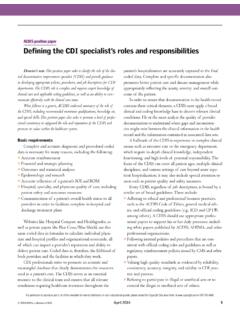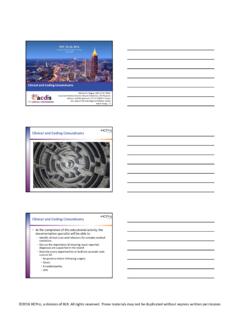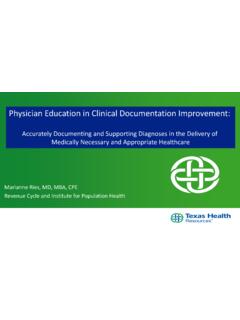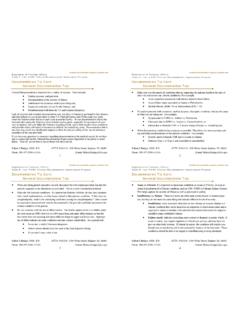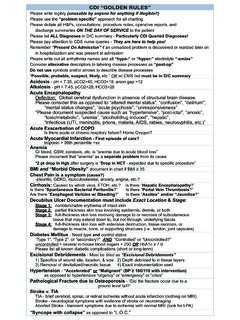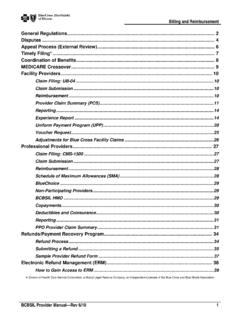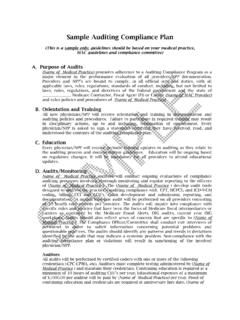Transcription of The “art” Clinical Validation - ACDIS
1 The art Clinical ValidationLAURIE L. PRESCOTT RN, MSN, CCDS, CDIPAHIMA APPROVED ICD-10 CM/PCS TRAINERCDI EDUCATION SPECIALIST HCPRO, A DIVISION OF BLRO bjectives Discuss the impact of Recovery Auditors/Private Pay Audits as related to Clinical Validation Define Clinical Validation vs DRG Validation Define the term Clinical indicators Discuss the use of Clinical indicators in query practice Construct queries to obtain missing/vague diagnoses Construct queries when there is no Clinical support for a documented diagnosesBack in the Provider documented a diagnosis We did not question validity of diagnosis We coded the diagnosis We got paid A new dimension has been are now experiencing a new world Kid in Recovery Auditors Arrived Introduction of the concept of Clinical Validation The
2 Game changed Recovery Auditors & Private Payer Auditors review records for: Medical Necessity Clinical Validation DRG ValidationWhat is DRG Validation ? The process of reviewing physician documentation and determining whether the correct codes and sequencing were applied to the billing of the claim. Review focuses on physician documentation and code assignment in comparison to the Official Guidelines of coding and Reporting Performed by a certified coder Answers the question Did we code it correctly? Journal of AHIMA: is Clinical Validation ? The process of Clinical review of a claim to see whether or not the patient really has the conditions that were documented.
3 Performed by a clinician, retrospectively after claims submission The Recovery Audit Statement of Work states this is NOT the coder s responsibility May result in claims denial when the Clinical indicators in the record do not support the reported diagnoses and procedures. Centers for Medicare and Medicaid Services. "RAC Statement of Work." September 1, 2011 are Clinical Indicators? Clinical indicators offer support within the record for the diagnoses applied to the patient. They can consist of: Laboratory or diagnostic test results Imaging studies Treatments-medications, interventions, infusions, services Patient s response to treatment Patient assessments and plans of care (by all caregivers) Symptoms Observations Objective data-vital signs, height/weight etc.
4 Traditional use of Clinical Indicators Coders and CDIS have traditionally used Clinical indicators to support aquery for vague, incomplete or missing diagnoses. The AHIMA/ ACDIS Query Practice Brief of 2013 states: To support why a query was initiated, all queries must be accompanied by the relevant Clinical indicator(s) that show why a more complete or accurate diagnosis or procedure is requested. Clinical indicators should be derived from the specific medical record under review and the unique episode of care. Clinical indicators supporting the query may include elements from the entire medical record, such as diagnostic findings and provider impressions. Traditional Use of Clinical Indicators Guidelines for Achieving a Compliant Query Practice continues to state: A leading query is onethat is notsupported by the Clinical elements in the health record and/or directs a provider to a specific diagnosis or procedure.
5 The justification ( , inclusion of relevant Clinical indicators) for the query is more important than the query format. coding and CDI staff are quite comfortable in identifying Clinical indicators that are used to support a query to obtain missing, vague or incomplete diagnoses. This has been and continues to be an important part of our daily practice both on the concurrent and retrospective side. Sources to Establish Clinical Indicators AHA coding Clinics AHRQ-Agency of Healthcare Research and Quality Professional Organizations specific to the appropriate diagnosis ASPEN-Nutritional Diagnoses American Society of Parenteral and Enteral Nutrition KDIGO-Renal Function American College of Cardiologist Foundation/ American Heart Association Surviving Sepsis Campaign Practice-Establish Organizational Defined Criteria Targets those diagnoses that are vulnerable to challenge Establishes consistency in query practice by coders and CDIS Use as teaching tools for medical staff/ ancillary staff Promotes consistent documentation by all who document within
6 The record Common diagnoses: Acute renal failure, respiratory failure-acute and chronic, levels of malnutrition, encephalopathy, sepsis, severe of Clinical IndicatorsSepsis Fever (> 101 F/ > C) or hypothermia (< F/ < C) WBC > 12,000 or <4,000 or >10% Bands Tachycardia Tachypnea Elevated procalcitonin Elevated C-reactive protein Altered mental status Non-diabetic hyperglycemia (blood sugar > 120mg/dl) Evidence of acute organ failuresurviving Sepsis Campaign: International Guide-lines for management of severe sepsis and septic shock, 2012. Critical Care Medicine 2013;41 of Clinical IndicatorsSepsisTreatment Includes: IV antibiotics IV Fluids-aggressive hydration Monitoring of organ function Supportive measures to maintain organ perfusion/function Oxygen Vasopressors Monitoring of vital signs, urine output, etc.
7 Surviving Sepsis Campaign: International Guide-lines for management of severe sepsis and septic shock, 2012. Critical Care Medicine 2013;41 for Sepsis ED record demonstrates respiratory rate of 32 per minute, HR of 96, febrile with admission temp of . Blood cultures positive for e coli. Metabolic encephalopathy and UTI identified as admission diagnoses. diagnostics demonstrated an elevated pro-calcitonin ( ng/ml). Treatment includes antibiotics, oxygen and fluids. Please clarify the condition you are monitoring and treating. A. UTI with sepsis B. UTI only C. Other _____ D. UnknownExample of Clinical IndicatorsChronic Respiratory Failure Hypoxemia (baseline pO2 <60) Chronic Home Oxygen Baseline elevated pCo2, elevated bicarblevel, with normal pH ( ) Polycythemia Cor-pulmonaleQuery for Chronic Respiratory FailureMrs.
8 Smith has been admitted for acute on chronic systolic heart failure. Respiratory assessment indicates patient is dependent on home oxygen and is maintained on 2-3 liters NP. Documentation also states a compensated respiratory acidosis, with elevated bicarblevels. Your documentation indicates aggressive pulmonary toilet and monitoring to prevent exacerbation of chronic lung disease. Please clarify the status of patient s chronic lung disease. respiratory of Clinical IndicatorsAcute Respiratory Failure Symptoms: Shortness of breath, dyspnea Tachypnea Labored breathing, wheezing, stridor Accessory muscle use, nasal flaring, grunting diagnostics : Hypoxemia (pO2 < 60 mmHg/ SpO2 < 91% on room air Hypercapnea(pCo2 >50 mmHg with pH < Treatment: Supplemental oxygen BiPap, CPAP Treatment of underlying conditionPinson, R.))
9 , Tang, C. The 2015 CDI Pocket Guide. HcPro, a Division of BLR. of Clinical Indicators-Malnutrition Physical Findings emaciation, cachexia, muscle wasting, temporal wasting Risk Factors cancer, chemotherapy, HIV disease, malabsorption, end stage organ disease, digestive disorders Biochemical Factors low albumin, prealbumin, cholesterol, transferrin, anemia Body mass Composition Low BMI, recent or progressive unintended weight lossDiagnostic Resources-Malnutrition ASPEN-American Society for Parenteral and Enteral Nutrition WHO-Pediatric Standards Merck Manual of Clinical IndicatorsEncephalopathy Acute or sub-acute mental status alteration associated with metabolic or toxic factors Will demonstrate improvement with removal of underlying metabolic or toxic factors Does not wax and wane Treatment addresses the underlying insult and maintaining patient safety in the setting of altered mental Has Sepsis?
10 Really? What do we do when we have an over exuberant provider? The provider who gives everyone the diagnosis of sepsis? Or acute respiratory failure? How do we address the situation where we have a documented diagnosis but no Clinical indicators within the record to support its presence?Who starts the conversation? The Coder? The CDI specialist? The HIM Director? The CDI Director? The Physician Advisor?Examples: Escalation Policy A multi-disciplinary committee (consisting of physicians, quality, compliance, and HIM staff) to review cases submitted by CDI and coding staff when diagnoses are inconsistent with the patient s Clinical picture, or the Clinical picture is inconsistent with the diagnoses.
